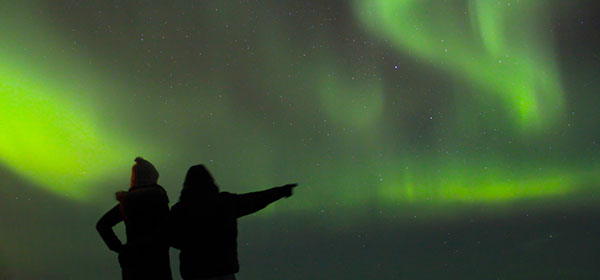As with many Australians, seeing the Northern Lights is high on Richard’s bucket list. In today’s Travel SOS, he asks Lee Mylne about the best spot to see the Aurora Borealis.
Q. Richard
I’ve seen some amazing photos of the Northern Lights, and I’d love to see them for myself. Where are the best places to go to see this incredible sight?
A. Well, Richard, the world is your oyster to some extent! Or at least you’ve got a good choice of several countries in the north of the northern hemisphere – in what is known as the Northern Lights zone. That zone falls between the latitudes of 65 and 72 degrees, and encompasses several countries – Canada, Alaska, the Scandinavian countries of Denmark, Sweden and Norway, as well as Finland, Russia, Iceland and even Scotland.
Plan your trip to see this wonderful natural phenomenon, the Aurora Borealis (Northern Lights) for sometime between late November and March. This is when the conditions are just right – clear and cloudless skies, with little light – to see the spectacular colourful displays created when solar particles collide with atmospheric gases. Of course, it’s also the coldest time of year, but the crisp air will keep you awake! The different altitudes and gases in each place create different Aurora colours, however, green is the most common.

Canada and Alaska – popular with Australian travellers at any time – are good places to see the Aurora. Alaska’s location within ‘the zone’ means you’re almost guaranteed to see spectacular light displays, but keep in mind that you’ll need to move beyond the city lights of Fairbanks into the wilderness areas of Denali and the Yukon.
In Canada, some of the best viewing can be had in areas around Lake Superior in Ontario and the town of Whitehorse in the Yukon Territory (which covers both Alaska and Canada).
The Scandinavian countries also offer prime spots for seeing the Northern Lights. In Norway, the northern towns of Tromsø, Svalbard, Finnmark, Alta, and Svovær (in the Lofoten Islands) are regarded as among the best places to try. You could also take a cruise along Norway’s fjord-lined coast (with the advantage that the ships usually give wake-up calls when the lights are ‘performing’).
In Swedish Lapland, head to Abisko National Park, known for its ‘blue hole’ – a patch of permanently clear sky – above the park’s 70km long lake. This area has a unique micro-climate that makes it an ideal viewing spot for the Aurora Borealis.
Finland was where I headed last November, in my own attempt to see this remarkable natural phenomenon. I based myself for a few nights first in the Finnish Lapland town of Ivalo and then at the wonderful Kakslauttanen resort (where you can also stay in a glass igloo for viewing in comfort). However, I was unlucky because weather conditions were not good, and I did not see so much as a glimmer of the Aurora. The bonus was that I did see wonderful snow! Other places in Finland from where to witness the Aurora include: Sodankyla, where the Northern Lights Research Centre is based (a good sign); and Nellim, which is close to one of Finland’s largest lakes, Lake Inari.
In theory, you can also view the Northern Lights from Denmark and Scotland, but both of these locations are renowned for their stormy weather rather than their clear skies, so your chances of good viewing are more remote.
In Russia, Murmansk is a popular base for Aurora-chasing – but remember that the temperatures will be below freezing! Iceland’s Thingvellir National Park is one of the best locations … but in fact almost anywhere outside the capital Reykjavik will give you a good chance.

If you really want to go where few venture, head to Greenland’s Kulusuk and Ammassalik; but like Iceland, you can see the Northern Lights from almost anywhere when the conditions are right.
Don’t forget that nothing is guaranteed when it comes to nature, and that you will probably need a lot of patience. Be prepared to wait in very cold temperatures in the middle of the night to see the Aurora. I’m told it is worth the wait! Most accommodation in these areas will run tours and give you good advice about how and where to maximise your chances of seeing the Lights.
And don’t forget that you don’t have to travel to the northern hemisphere to see this marvellous light show. Much closer to home, you can head to Tasmania for the Aurora Australis, or Southern Lights. That’s going to be my next attempt!
Do you have a travel question for Lee? If so, email your Travel SOS to [email protected]
Related articles:
The Northern Lights in Yukon
More than the Northern Lights
Why everyone loves a polar bear

